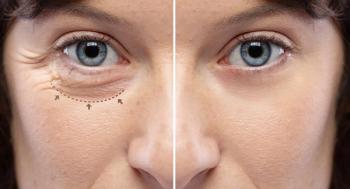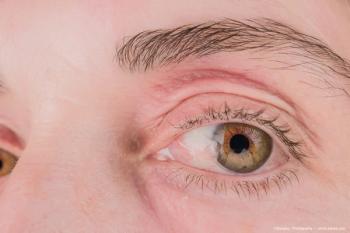
Imaging device for newborns may prompt universal vision screening
The recent approval of an imaging device for newborn vision screening allows clinicians to image the anterior and posterior segments, the angle, and the fundus.
Take-home message: The recent approval of an imaging device for newborn vision screening allows clinicians to image the anterior and posterior segments, the angle, and the fundus.
By Fred Gebhart; Reviewed by Darius M. Moshfeghi, MD
Stanford, CA-A newly approved device for vision screening of all newborns (Panocam LT Wide-Field Imaging System, Visunex Medical Systems) captures a 130o field of view of the anterior and posterior segments.
The hand-held imaging device-about the size of a cell phone-connects wirelessly to a portable base unit the size of a small suitcase, allowing image capture in multiple suites or exam lanes.
Editorial:
“You can only treat what you see and you can only see if you look,” said Darius M. Moshfeghi, MD, professor of vitreoretinal surgery and director of ophthalmic telemedicine, Byers Eye Institute, Stanford University School of Medicine, Stanford, CA.
“At this point, we only screen for retinopathy of prematurity, about 80,000 infants of the approximately four million live births in the United States each year,” Dr. Moshfeghi said. “The other 3.92 million infants get no vision screening until kindergarten."
Blog:
“We know from our own and others’ studies that up to 5% of those unscreened infants have some sort of visual pathology that could be detected at birth and treated-but only if we look for it,” he added.
Universal newborn vision screening
The device is the first step in a campaign for universal newborn vision screening. This is the first imaging system that is designed for general use, said David Yeh, general manager, Visunex.
The image capture unit is designed for nurses, technicians, birthing physicians, and other non-ophthalmic personnel, Yeh said.
Recent:
The image capturing system provides a wide field of view (with a minimum of 130°) of the anterior or posterior segment. Examples of fundus images are shown. (Images courtesy of Visunex Medical Systems)
The unit can be used to capture the infant’s face, and then held in contact with the infant’s eye to image the anterior and posterior segments, the angle and the fundus. The current generation unit captures a 13-megapixel image.
An AI program guides the user through image capture. The user is directed to place the optic nerve inside a small box on the display. The box moves with each image, forcing the user to reposition the device to capture each quadrant in the proper sequence. A joystick provides one-handed operation for brightness, focus, and all image capture functions.
Related:
Images are encrypted and can be sent wirelessly to the base unit or stored for later batch transmission. The base unit includes encrypted removable storage, a color printer and hardware/software for secure wireless, encrypted transmission to a telemedicine reviewer, the hospital’s electronic health record and cloud storage.
Neither the image capture unit nor the base unit operate on wi-fi or bluetooth frequencies, Yeh said, and will not interfere with hospital patient care or communication systems.
Recent:
Images can be reviewed immediately by a qualified pediatric ophthalmologist or downloaded at a later time for review.
“Because we have captured the images in the expected order, all the ophthalmologist has to do is look at the images and say ‘yes or no,’ ‘normal or not,’ in a few seconds,” Yeh said. “Reviewers have the ability to look at hundreds of eyes, not just one or two.”
The system is fully HIPAA compliant, he added. Image data are transmitted in two separate secure streams and stored in two separate clouds.
One stream and cloud carries the images, identified only by a random numeric code. A second stream and cloud carries patient information, including name, date of birth, weight and other details, identified by the matching numeric code. The only way to link any specific image with a specific patient is to hack both streams and break the encryption on each.
Early detection, intervention
Universal visual screening is a particularly useful newborn procedure, Dr. Moshfeghi said. Most pediatric ophthalmologic disease is both evident and actionable at birth.
IN VIEW: Newborn screening with the vision diagnostic system can provide early detection of disorders, such as retinoblastoma, a condition which tends to be fatal if not treated, according to Darius M. Moshfeghi, MD. (Images courtesy of Visunex Medical Systems)
Dr. Moshfeghi conducted the Newborn Eye Screening Test, or NEST, a prospective screening offered to every newborn at Stanford Medical Center. The results of NEST were consistent with reported rates of hemorrhagic pathology ranging between 10% to 20% in China, Brazil and Spain, as well as 1% to 2% non-hemorrhagic pathology.
Recent:
“Universal screening can pick up things like retinoblastoma, which tends to be fatal if you don’t treat it,” Dr. Moshfeghi said. “We don’t normally pick it up until 10 to 12 months in the germline form or 18 to 24 months in the sporadic.
There are numerous diseases in which clinicians can intervene and make a difference if they are caught early-such as persistent fetal vasculature, familial exudative vitroretinopathy, retinal detachment, vitreous hemorrhage, cataracts, and glaucoma.
“They are all waiting to be discovered and treated,” he said. “But we can’t discover any of it until we start looking.”
Recent:
Distribution of the device is projected to begin by mid-year.
Dr. Moshfeghi said newborn visual screening would be introduced as an elective, cash-pay service. Prices will be set by each institution, but are expected to fall into the $100 to $150 per-infant range.
Darius M. Moshfeghi, MD
Dr. Moshfeghi did not indicate any propriety interest in the subject matter.
Newsletter
Don’t miss out—get Ophthalmology Times updates on the latest clinical advancements and expert interviews, straight to your inbox.









































